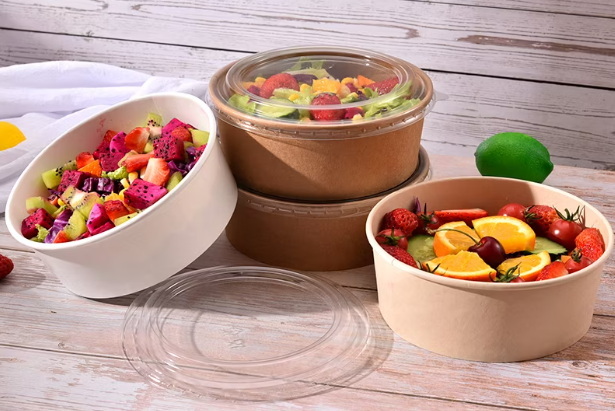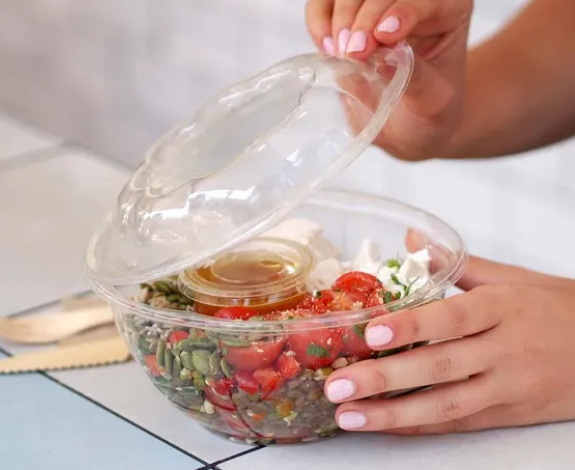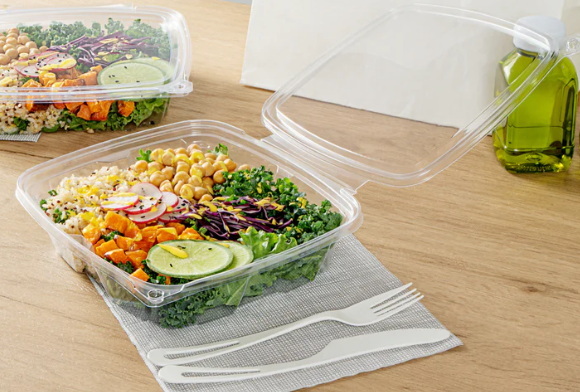
Content Menu
● Introduction to Cheese Storage
>> Types of Cheese and Storage Needs
● Disposable Salad Bowls: An Overview
>> Features of Disposable Salad Bowls
● Using a Disposable Salad Bowl for Cheese Storage
>> Potential Drawbacks
● Alternative Storage Methods
>> Cheese Vaults
>> Cheese Paper
● Advanced Cheese Storage Techniques
>> Aging Cheese at Home
>> Monitoring Cheese Condition
● The Role of Temperature in Cheese Storage
>> Impact of Temperature Fluctuations
● Humidity and Cheese Storage
>> Maintaining Optimal Humidity
● Innovative Cheese Storage Solutions
>> Smart Cheese Containers
● Cultural Aspects of Cheese Storage
>> Cheese in Different Cuisines
● The Art of Cheese Pairing
>> Tips for Cheese Pairing
● Cheese in Global Cuisine
>> Integrating Cheese into Traditional Dishes
● The Future of Cheese Storage
● Conclusion
● FAQs
>> 1. What is the best material for storing cheese?
>> 2. Can I store different types of cheese together?
>> 3. How often should I re-wrap my cheese?
>> 4. Is freezing cheese a good storage method?
>> 5. What is the ideal temperature for cheese storage?
● Citations:
In the quest for innovative ways to store cheese, one might wonder if a disposable salad bowl with 3 compartments could be repurposed for this purpose. While these bowls are designed primarily for salads and other take-out foods, their compartmentalized design could theoretically keep different types of cheese organized and fresh. However, the effectiveness of using such a bowl for cheese storage depends on several factors, including the type of cheese, the material of the bowl, and how it is used.

Introduction to Cheese Storage
Cheese storage is an art that requires careful consideration of temperature, humidity, and air circulation to maintain freshness and flavor. Different types of cheese have unique storage needs, ranging from soft cheeses like Brie, which require a humid environment, to hard cheeses like Cheddar, which can tolerate drier conditions.
Types of Cheese and Storage Needs
1. Soft Cheeses: These cheeses, such as Brie and Camembert, need a humid environment to prevent drying out. They are best stored in a breathable material like parchment paper or cheese paper, wrapped loosely to allow for air circulation.
2. Hard Cheeses: Cheeses like Cheddar and Gouda can be stored in a drier environment. They are often kept in airtight containers to prevent moisture from affecting their texture.
3. Semi-Soft Cheeses: These cheeses, including Swiss and Edam, fall somewhere in between and can be stored similarly to hard cheeses but may benefit from a slightly more humid environment.
Disposable Salad Bowls: An Overview
Disposable salad bowls, especially those with compartments, are designed for convenience and organization. They are typically made from materials like PET plastic or biodegradable alternatives like sugarcane/bagasse. While these materials are durable and suitable for food, their suitability for long-term cheese storage is questionable.
Features of Disposable Salad Bowls
- Material: Most disposable bowls are made from PET plastic, which is durable but not ideal for long-term storage due to potential moisture issues.
- Compartments: The compartmentalized design can help keep different cheeses separate, which is beneficial for preventing flavor transfer.
- Tamper-Evident Lids: Some bowls come with tamper-evident lids, which provide a secure seal but may not offer the breathability needed for cheese storage.
Using a Disposable Salad Bowl for Cheese Storage
To use a disposable salad bowl with 3 compartments for cheese, consider the following steps:
1. Choose the Right Cheese: Opt for cheeses that can tolerate a slightly drier environment, such as semi-hard or hard cheeses.
2. Wrap the Cheese: Wrap each type of cheese in parchment or waxed paper before placing it in the bowl to maintain humidity and prevent sticking.
3. Store in the Refrigerator: Place the bowl in the refrigerator, ideally in a consistent temperature zone like the cheese drawer.
Potential Drawbacks
- Moisture Control: PET plastic may not provide the optimal moisture control needed for long-term cheese storage.
- Breathability: The bowls are designed to be airtight, which can lead to moisture buildup and mold if not managed properly.
Alternative Storage Methods
For optimal cheese storage, consider using specialized containers designed for cheese, such as cheese vaults or cheese paper.
Cheese Vaults
Cheese vaults are made from materials like silicone and have a ridged bottom that allows for air circulation while maintaining humidity. They are ideal for long-term storage and can keep cheese fresh for up to 40 days.
Cheese Paper
Cheese paper is specifically designed to allow cheeses to breathe while maintaining moisture. It is an excellent option for storing a variety of cheeses.
Advanced Cheese Storage Techniques
Beyond basic storage, there are advanced techniques to enhance cheese preservation:
Aging Cheese at Home
Some cheeses, like Parmesan and Cheddar, can be aged at home to develop a richer flavor. This involves storing them in a controlled environment with precise temperature and humidity levels.
Monitoring Cheese Condition
Regularly inspect your cheese for signs of spoilage, such as mold or an off smell. If you notice any issues, it's best to consume the cheese quickly or discard it.
The Role of Temperature in Cheese Storage
Temperature plays a crucial role in maintaining the quality of cheese. Most cheeses should be stored at a consistent refrigerator temperature between 35°F and 45°F. This helps prevent bacterial growth and maintains the cheese's texture.
Impact of Temperature Fluctuations
Avoid placing cheese near the refrigerator door or in areas where temperature fluctuations are common. Consistency is key to preserving cheese quality.

Humidity and Cheese Storage
Humidity is another critical factor in cheese storage. Soft cheeses require higher humidity to prevent drying out, while hard cheeses can tolerate drier conditions.
Maintaining Optimal Humidity
For cheeses that require higher humidity, you can place them in a sealed container with a damp cloth to maintain moisture levels.
Innovative Cheese Storage Solutions
Innovative solutions are emerging to make cheese storage more efficient and effective. These include smart containers that monitor temperature and humidity levels, ensuring optimal conditions for cheese preservation.
Smart Cheese Containers
These containers use sensors to monitor and adjust the environment, providing real-time feedback on the cheese's condition. They are ideal for serious cheese enthusiasts who want to ensure their cheese is always at its best.
Cultural Aspects of Cheese Storage
Cheese storage practices vary across cultures, reflecting local traditions and the types of cheese commonly consumed. For example, in France, cheese is often stored in a cool cellar with controlled humidity, while in Italy, cheeses like Parmesan are aged in large wheels that allow for natural air circulation.
Cheese in Different Cuisines
Cheese plays a significant role in many cuisines around the world. In Mediterranean cuisine, feta and ricotta are staples, while in European cuisine, cheeses like Gouda and Cheddar are widely used. Understanding these cultural contexts can help in choosing the right storage methods for different types of cheese.
The Art of Cheese Pairing
Cheese pairing is an art that involves combining cheeses with other foods to enhance their flavors. When storing cheese for pairing, consider how different cheeses will complement each other and other ingredients like fruits, nuts, and crackers.
Tips for Cheese Pairing
- Balance Flavors: Combine strong cheeses with milder ones to balance flavors.
- Consider Textures: Mix soft and hard cheeses for a varied texture experience.
- Experiment with Combinations: Try pairing cheeses with different fruits, nuts, and spreads to find your favorite combinations.
Cheese in Global Cuisine
Cheese is increasingly being used in diverse cuisines to add new dimensions of flavor. For instance, in traditional Chinese cuisine, cheeses like Parmesan and Gouda are being incorporated into dishes like congee carbonara and fried rice to enhance their flavor profiles[4].
Integrating Cheese into Traditional Dishes
- Congee Carbonara: Adding Parmesan cheese to congee creates a creamy breakfast dish.
- Fried Rice with Gouda: Grated Gouda adds a nutty flavor to fried rice.
- Chinese Pork Burgers with Aged Cheddar: Aged Cheddar complements the spiced pork belly in these burgers.
The Future of Cheese Storage
As technology advances, we can expect to see more innovative solutions for cheese storage. From smart containers to automated cheese aging systems, these advancements will make it easier for cheese enthusiasts to enjoy their favorite cheeses at optimal freshness.
Conclusion
In conclusion, while a disposable salad bowl with 3 compartments can be used for temporary cheese storage, it is essential to consider the specific needs of different cheeses for optimal freshness and flavor. Investing in specialized cheese storage solutions and understanding cultural and culinary contexts can elevate your cheese storage and enjoyment experience.

FAQs
1. What is the best material for storing cheese?
The best material for storing cheese depends on the type of cheese. For most cheeses, breathable materials like parchment paper or cheese paper are ideal. For long-term storage, silicone cheese vaults are excellent.
2. Can I store different types of cheese together?
Yes, you can store different types of cheese together, but it's best to keep strong-smelling cheeses separate to prevent flavor transfer. Use dividers or separate containers if possible.
3. How often should I re-wrap my cheese?
Re-wrap your cheese every two to three days to ensure freshness and prevent moisture buildup.
4. Is freezing cheese a good storage method?
Freezing is not recommended for most cheeses as it can alter their texture and flavor. However, if you must freeze, thaw the cheese in the refrigerator and use it for cooking.
5. What is the ideal temperature for cheese storage?
The ideal temperature for cheese storage is between 35°F and 45°F, with high humidity. The crisper drawer of the refrigerator is often ideal.
Citations:
[1] https://cheeseforthought.com/long-term-cheese-storage/
[2] https://hmhub.in/2nd-sem-food-production-notes/uses-of-cheese/
[3] https://cheeseforthought.com/best-practices-for-cheese-storage/
[4] https://www.nzmp.com/global/en/news/leverage-cheese-to-enliven-traditional-Chinese-cuisine.html
[5] https://www.partstown.com/about-us/cheese-storage-tips-to-avoid-spoiling
[6] https://en.wikipedia.org/wiki/List_of_cheese_dishes
[7] https://guide.michelin.com/hk/en/article/dining-in/%E5%A6%82%E4%BD%95%E4%BF%9D%E5%AD%98%E8%8A%9D%E5%A3%AB
[8] https://culturecheesemag.com/cheese-bites/everything-you-know-about-cheese-history-is-wrong/
[9] https://www.ice.edu/blog/exploring-different-culinary-uses-firm-cheeses
[10] https://cheesegrotto.com/pages/cheese-grotto-a-philosophy-and-methodology
[11] https://www.jstor.org/stable/10.1525/gfc.2012.11.4.112
[12] https://www.ice.edu/blog/understanding-fresh-cheeses-and-their-culinary-uses
[13] https://www.chucklingcheese.co.uk/news/cheese-gift-guides/cheese-storage-tips-for-winter
[14] https://henningscheese.com/wp-content/uploads/2023/05/storage_temperatures_necessary_to_maintain_cheese_safety.pdf
[15] https://academyofcheese.org/have-you-tried-cooking-with-cheese/
[16] https://www.cheeseprofessor.com/blog/keeping-cheese-fresh
[17] https://www.dsm-firmenich.com/en/businesses/taste-texture-health/news-events/articles/dairy/role-of-cultures-and-coagulants.html
[18] https://www.thecheesemaker.com/blog/cheese-cultures-explained-everything-you-need-to-know/
[19] https://cheesemaking.com/blogs/learn/learn-about-cultures-for-cheese-making
[20] https://brouwland.com/en/index.php?controller=attachment&id_attachment=6590

















